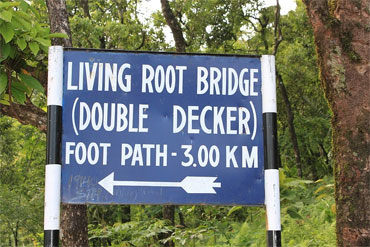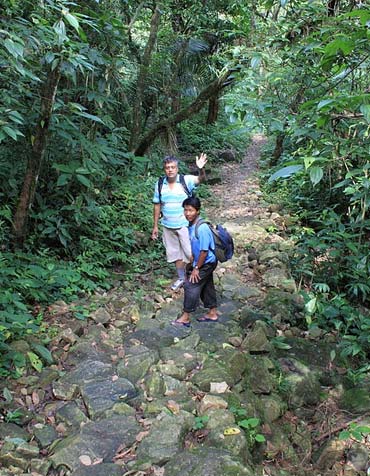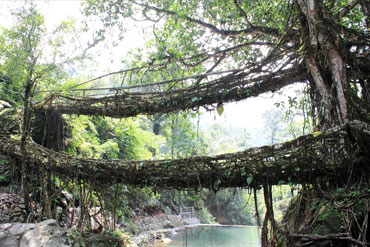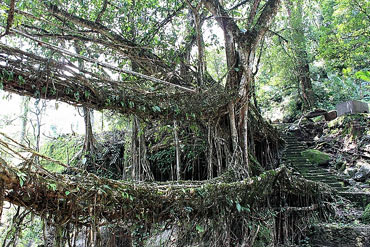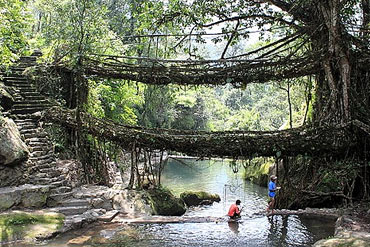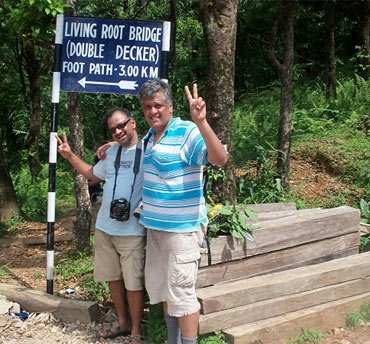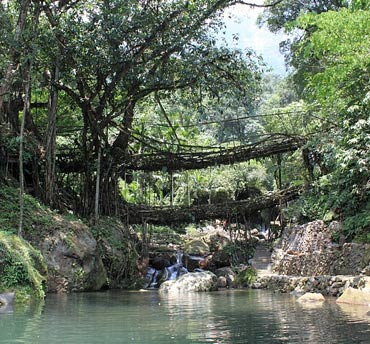 | « Back to article | Print this article |
Travel: Trekking to the living bridges of Cherrapunji
Although a wonder like the double-decker living root bridge in Meghalaya should not remain in oblivion and hidden from the world, it is also important to ensure it is left untouched in nature's care, say Vivek Garg and Ravishankar Mantha.
It is unusual to return from a doctor's clinic with a vacation idea! However, that is exactly what happened with us when, while waiting at a clinic's reception, we came across an article on living root bridges of Meghalaya in a travel magazine. A quick round of discussion with family and friends and our summer holiday plans were finalized. We were going to Meghalaya!
Our group had a thrilling time in Meghalaya. However, when we were told that a visit to Double Decker is a rough trek and not advisable with family, we were a bit heart-broken.
But then whoever said, 'Where there is a will there is a way' was absolutely right. We certainly did not want to miss this opportunity and the two of us decided to visit the Double Decker on our last day in Cherrapunji. Thankfully our families allowed the two of us to go while they stayed back at the resort to enjoy their time.
Starting our trek
We left early in the morning at 6:30 am with our guide Bhadang, and after 45 minutes of a cool drive reached the starting point of the trek in Umsohphie village. At 7.30 am we started our hike.
The first 3 km was concrete footpath constructed in 2007 up to Nongthymmai village. About half an hour later we reached Nongthymmai, the quaint village welcomed us with its simple yet charming environment.Sharing happy moments
There were traditional Khasi (this area is part of East Khasi Hills of Meghalaya) houses and very sweet and happy villagers.
One couple with their new born baby was all smiles which made us stop by and share their happy moments... remember the song Kisi ki muskurahaton pe ho nisaar from Raj Kapoor's Anari?
Hiking through the jungle
As we moved ahead, we came across beautiful flora and fauna of the lush green jungle and encouraging sign boards indicating that we were on the right track.
It is easy to lose your way in these unknown jungles and we were happy Bhadang was there to guide us.
On the iron footbridge
At 8.45 am, after walking for about 75 minutes, we reached a very narrow iron suspension footbridge we had to take to cross a fast flowing river. It was important to put every step very carefully.
The bridge was unexpected but this was perhaps the most entertaining part of the trek. The view of the river from the bridge was splendid. The sound of crystal clear water forcing its way through the amazing rock patterns was music to our ears!
Bhadang then pointed to the top of a hill far behind us and informed that it was our starting point. Wow! We felt happy that we had covered a lot of distance but there still was a long way to go.
Tranquil beauty
After some time we were on a small root bridge and stopped to admire its beauty and the tranquility of the jungle around us. Our curiosity to see the Double Decker was now on a high.
After about 2 hours of trekking through the beautiful jungle, this was the motivational push to go for that last mile!
Soon we were at Nongriat village, the last village before our final destination. A couple of minutes more and we were at the doorstep of the Double Decker Living Root Bridge!
The Double Decker Living Root Bridge
After 2.5 hours of a wonderful and tiring trek, the sight of the Double Decker was, for us, no less than reaching the summit of Mt Everest.
We had seen small root bridges on the way but this was absolutely amazing! It was as if the entire place had been kept neat, clean and perfect to receive us.
Nature's spa
However, we decided to take a closer look at the Double Decker later because a waterfall nearby was too tempting to resist.
The water was pure, cold and very forceful and refreshed our tired bodies. To us it was nature's spa. Soon we were heading towards to the bridge that still had to be explored!
The bridge forms a sturdy path across the Umshiang River
The Double Decker is a combination of two living root bridges one above the other. A living root bridge is made by weaving and entangling the secondary roots of a rubber fig (from the Banyan family).
The Double Decker root bridge forms a sturdy path across the Umshiang River whose water flows down from Cherrapunji's Nohkalikai Fall, one of the highest waterfalls in the world.
Local villagers use this bridge to cross the river for their daily activities and therefore it is a lifeline for them.
An enthralling experience
However, when we were there, there was no one else around and we could explore it with complete freedom and to our satisfaction. We had certainly earned it. For those moments it seemed like we owned the Double Decker.
However, these enthralling moments were running out as we had to return. After about one hour at the Double Decker, we bid farewell at 11 am and made our way back.
'We did it!'
Cherrapunji is supposed to be the wettest place on earth but there was no rain on that day. The sun was now blazing making the air hot and humid.
We had great memories of the Double Decker to keep us in good spirits but we wished the rain Gods would bless us!
After about 2.5 hours of return trek, we were back at the base. The only thought was, 'Oh yes! We did it, buddy.'
Our Meghalaya tour would have been incomplete without this double cherry -- a perfect finish.
Save nature
The Double Decker was magnificent but the experience of the journey was equally exciting. We were proud of our achievement but felt humbled by the hard working labourers and school children who travel the same path several times a day.
We could feel the pleasure of a peaceful jungle, the happiness of simple, heart-warming yet strong-willed people, the purity of unpolluted rivers with the air so fresh making us wish we had the same in our own city.
Although a wonder like the Double Decker Living Root Bridge in Meghalaya should not remain in oblivion and hidden from the world, it is also important to ensure it is left untouched in nature's care!
Want to share your travel story with us and others around the world? Simply write in to getahead@rediff.co.in (subject line: 'My Travel Story'), along with pictures of the destination you're writing about. We'll publish the best ones right here on rediff.com!

